This is the last post in a two-part series describing results from CMAP's survey of municipal staff to determine the status of local plans, programs, and operations. The first post focused on the survey methodology and on its findings with regard to municipalities' efforts to link land use and transportation and to address issues of the environment and housing. This second post looks at findings about local comprehensive plans, technical assistance, and data distribution. You may also wish to delve further into some of the data at MetroPulse.
Comprehensive Planning
One of the building blocks of local planning is having an up-to-date comprehensive plan. Comprehensive plans provide a vision and direction for long term development within a municipality. While many communities have recently adopted comprehensive plans that address issues of livability, there are many others whose plans are outdated, have been made irrelevant through zoning decisions (which often reflects a disconnect between the adopted plan and the realities of community development issues), or simply have never had a comprehensive plan.
Comprehensive plans must be updated periodically to reflect changes in economic conditions and resident preferences. Eighty-six percent of respondents indicated that their municipality has an approved comprehensive plan. Of those with a comprehensive plan, 62 percent indicated that their plan was adopted in the past 10 years.
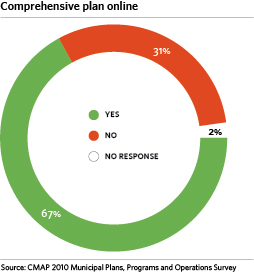
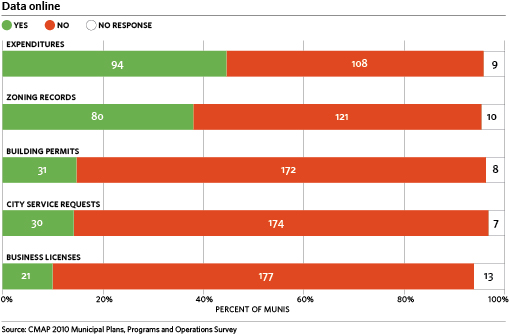
While each comprehensive plan's vision reflects the unique character of the municipality, it is important for consultants, plan commissions, and governments to consider the context of neighboring and overlapping jurisdictions. One way to do this is for municipalities to reach out to one and other during the planning process. Approximately half of respondents with a comprehensive plan reported that they did communicate with neighboring municipalities, counties, or other local jurisdictions (like park and school districts) during their most recent planning process.
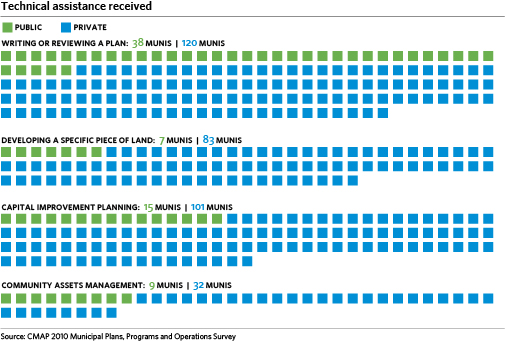
Another way municipalities may seek to understand their sub-regional context when developing comprehensive plans is to review the plans of neighboring and overlapping jurisdictions. Traditionally, only municipalities and counties would create comprehensive plans, but school and park districts may also develop capital or strategic plans that can affect land use and transportation within a municipality. More than half of the 182 municipalities with comprehensive plans said that they did review the plans and policies of neighboring local governments (either other municipalities or counties) during the planning process.
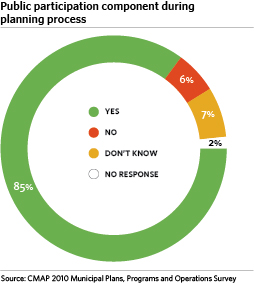
As CMAP seeks to implement the GO TO 2040 plan by providing local technical assistance to communities, it is important for the agency to have a baseline understanding of how many municipalities consider regional plan recommendations during their own planning process. Only 54 municipalities responded that their most recent comprehensive planning process had considered the regional plans that had been previously developed by CMAP's predecessor agencies, the Chicago Area Transportation Study and the Northeastern Illinois Planning Commission.
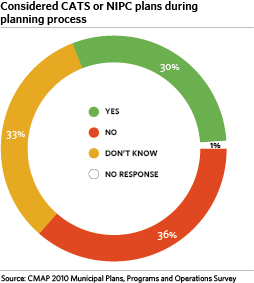
Public participation is an important part of any comprehensive planning process for several reasons. It is essential that residents have a voice in how the region formulates plans that will guide infrastructure and land development for decades to come. Increasingly, the federal government requires that robust public participation plans be part of proposals for planning funds. Ultimately, plans that have resident input are more likely to have support from residents. Eighty-five percent of respondents indicated that their most recent planning process included a public participation component.
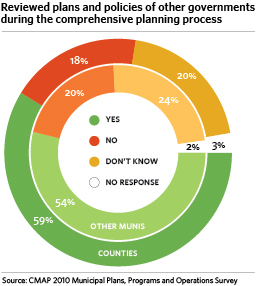
Technical Assistance
The capacity of each municipal government varies based on various factors, from the amount of revenue generated from property or local-option sales tax to municipal population and home rule status. As a result, there are also wide variations in the number of staff available for permit review and analysis of zoning variance applications, to say nothing of comprehensive planning. Thus, many municipal governments rely on private consultants, non-profits, or other government agencies like CMAP for technical assistance on various projects.
Data indicates that municipalities in our region are much more likely to receive technical assistance from private consultants than from public agencies or non-profits. Of the 211 responding municipalities, 175 reported having received assistance from a private entity, while only 71 reported receiving the same types of assistance from a public agency or nonprofit organization. The survey also asked respondents to identify if they had received technical assistance for writing or reviewing a plan; developing a specific piece of land; planning for capital improvement; or mapping community assets. Of these four options, respondents overall reported that they received the most technical assistance for writing or reviewing a plan.
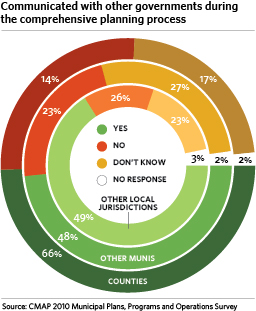
To help determine what technical assistance is most needed and most helpful, CMAP created the Compendium of Plans -- a review and summary of the comprehensive plans of all of the region's municipalities (to be updated every two years). This can be used to target technical assistance by providing an assessment of the current state of local comprehensive planning, and also to identify commonly missing or underemphasized elements of comprehensive plans. When assisting with comprehensive plan preparation, technical assistance providers should seek to make them truly comprehensive, addressing issues beyond land use and housing such as energy conservation, arts and culture, public health, and others. In March, CMAP posted a Policy Updatesummarizing a survey of the region's comprehensive plans.
Data Distribution
The public increasingly relies on data and information from business and government alike to understand their options and make important decisions. Most of policy and planning challenges are exacerbated by the difficulty of finding high-quality data.
Information sharing is a core function of CMAP, which since its inception has been committed to providing high-quality information and analysis to facilitate regional decision making. Now the agency is evaluating best practices in an effort to provide technical assistance for government units and other organizations across the seven counties to openly share their data with each other and with the public.
Improving access to information is a key recommendation of GO TO 2040. One of the GO TO 2040 success measures is to track the number of municipalities who make construction permits and zoning ordinances available online. This survey is the first step in that effort, by providing baseline data on both.
The survey asked respondents if they post any of the following data online: expenditures on infrastructure, public works, and social services; records of zoning actions; number of building permits; number of requests for city services (such as 911 calls); and number of business licenses. Almost half of the 211 responding municipalities (131, or 46 percent) reported that at least one of the five data items listed on the survey is publicly available online. Eight municipalities reported that all of the data items listed on the survey were available online.
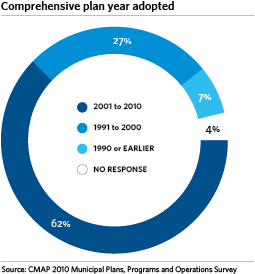
Of the 182 respondents who indicated that they have an approved comprehensive plan, roughly two-thirds indicated that it was posted online.
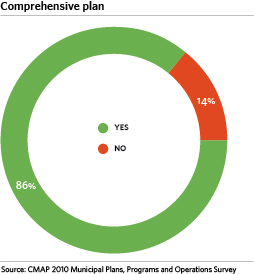
Conclusion
This two-part series of Policy Updates has summarized findings from the 2010 CMAP Municipal Plans, Programs, and Operations survey. The survey also asked a variety of questions to ascertain which municipalities have already implemented a variety of strategies recommended in GO TO 2040. If you are interested in drilling deeper into the data, please email Drew Williams-Clark at awilliamsclark@cmap.illinois.gov.
Technical assistance activities provided by CMAP will vary over time and will be detailed in each year's work plan. It is intended to be a proactive, rather than reactive, activity -- in other words, CMAP will identify priorities and then work collaboratively with communities to accomplish them, but the agency will also need to react to changing conditions. Possible opportunities for assistance will be evaluated based on how well they match CMAP's priorities, support the principles of GO TO 2040 in general, leverage other technical assistance activities being pursued by other organizations, or relate to short-term challenges or opportunities.